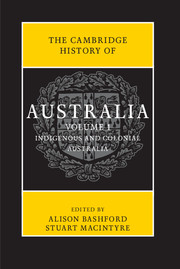Book contents
- Frontmatter
- Contents
- Abbreviations
- List of maps
- List of figures
- List of tables
- Notes on contributors
- Map
- Preface
- Introduction
- PART I
- PART II
- Further reading
- Chronology
- Index
- Frontmatter
- Contents
- Abbreviations
- List of maps
- List of figures
- List of tables
- Notes on contributors
- Map
- Preface
- Introduction
- PART I
- 1 Nation building, 1901–14
- 2 The Great War and its aftermath, 1914–22
- 3 Search for a solution, 1923–39
- 4 World War 2 and post-war reconstruction, 1939–49
- 5 The Menzies era, 1950–66
- 6 Instability, 1966–82
- 7 Growth resumed, 1983–2000
- 8 The new millennium
- PART II
- Further reading
- Chronology
- Index
4 - World War 2 and post-war reconstruction, 1939–49
from PART I
Published online by Cambridge University Press: 05 November 2013
- Frontmatter
- Contents
- Abbreviations
- List of maps
- List of figures
- List of tables
- Notes on contributors
- Map
- Preface
- Introduction
- PART I
- PART II
- Further reading
- Chronology
- Index
- Frontmatter
- Contents
- Abbreviations
- List of maps
- List of figures
- List of tables
- Notes on contributors
- Map
- Preface
- Introduction
- PART I
- 1 Nation building, 1901–14
- 2 The Great War and its aftermath, 1914–22
- 3 Search for a solution, 1923–39
- 4 World War 2 and post-war reconstruction, 1939–49
- 5 The Menzies era, 1950–66
- 6 Instability, 1966–82
- 7 Growth resumed, 1983–2000
- 8 The new millennium
- PART II
- Further reading
- Chronology
- Index
Summary
On 3 September 1939 Prime Minister Robert Menzies announced on national radio that it was his ‘melancholy duty’ to inform the Australian people that they were at war with Germany following its invasion of Poland. The Dominions of Canada and South Africa gave parliamentary consideration before they entered the conflict, in accordance with the Statute of Westminster of 1931, which granted Dominions the power to act independently from Britain. Concerns that the Statute might weaken ties with Britain delayed its ratification by Australia until 1942. Hence Menzies stated that Britain was at war with Germany and ‘as a result, Australia is also at war’.
The entry into a second world war was greeted with little of the imperialist enthusiasm so evident among Australians in 1914. Twenty-five years later many families still mourned lost sons, brothers and husbands. As Australia emerged from the economic hardship of the Depression and sought to build a firmer manufacturing base, war presaged further years of uncertainty.
If World War 2 was unwelcome, it was not unexpected. Australia had watched the rise of fascism during the 1930s with mounting unease. In 1935 Italy invaded Ethiopia, and in 1936 the Spanish Civil War broke out. The Coalition government of the United Australia Party (UAP) and Country Party led by Joseph Lyons supported the British stance of non-intervention and was anxious that the trade route through the Mediterranean be kept clear. Many Catholics supported Franco's uprising in Spain, while the Communist Party and others on the left advocated the cause of the Republic. As Hitler embarked on further aggression, the government encouraged the British policy of appeasement in Europe and suppressed criticism of Mussolini and Hitler. Lyons supported the British prime minister Neville Chamberlain's Munich Agreement of September 1938, which acquiesced in Germany's annexation of the Sudeten territories in Czechoslovakia.
- Type
- Chapter
- Information
- The Cambridge History of Australia , pp. 88 - 111Publisher: Cambridge University PressPrint publication year: 2013
- 5
- Cited by



